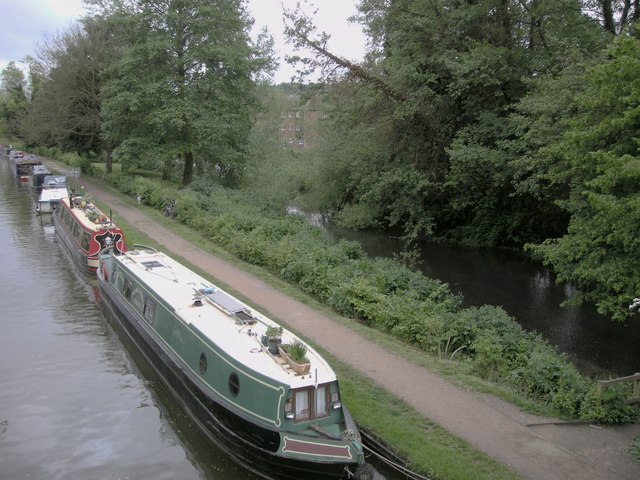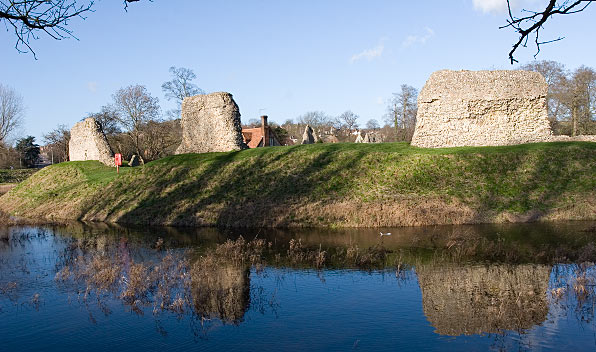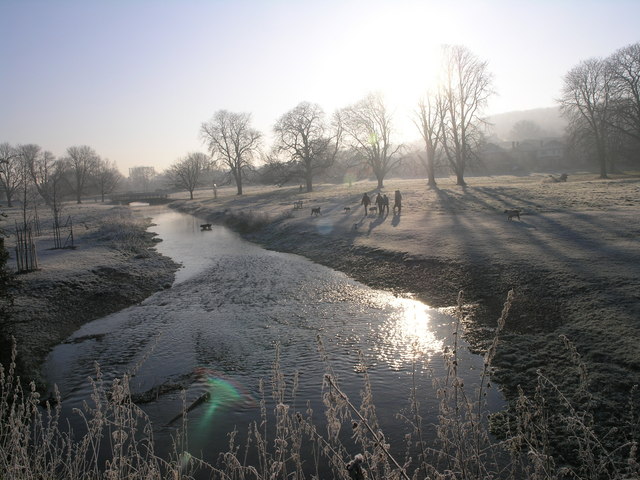River Bulbourne on:
[Wikipedia]
[Google]
[Amazon]
The River Bulbourne is a small river in
 The River Bulbourne was historically rich in eels and other fish, fast-moving and prone to frequent localised flooding; this has led it to being classified as a statutory
The River Bulbourne was historically rich in eels and other fish, fast-moving and prone to frequent localised flooding; this has led it to being classified as a statutory  Early
Early
 The Bulbourne flows through Boxmoor, and it was on this stretch that a major river restoration project was undertaken in January 2017. Working in conjunction with the
The Bulbourne flows through Boxmoor, and it was on this stretch that a major river restoration project was undertaken in January 2017. Working in conjunction with the
River Bulbourne interactive map
on the Chilterns AONB website {{DEFAULTSORT:Bulbourne Rivers of Hertfordshire Dacorum 2Bulbourne
Dacorum
Dacorum is a Non-metropolitan district, local government district with borough status in the United Kingdom, borough status in Hertfordshire, England. The council is based in Hemel Hempstead. The borough also includes the towns of Berkhamsted ...
, Hertfordshire
Hertfordshire ( or ; often abbreviated Herts) is a ceremonial county in the East of England and one of the home counties. It borders Bedfordshire to the north-west, Cambridgeshire to the north-east, Essex to the east, Greater London to the ...
, England
England is a Countries of the United Kingdom, country that is part of the United Kingdom. It is located on the island of Great Britain, of which it covers about 62%, and List of islands of England, more than 100 smaller adjacent islands. It ...
. The word bourne derives from the Anglo-Saxon
The Anglo-Saxons, in some contexts simply called Saxons or the English, were a Cultural identity, cultural group who spoke Old English and inhabited much of what is now England and south-eastern Scotland in the Early Middle Ages. They traced t ...
word for a stream
A stream is a continuous body of water, body of surface water Current (stream), flowing within the stream bed, bed and bank (geography), banks of a channel (geography), channel. Depending on its location or certain characteristics, a strea ...
. It is an unnavigable tributary
A tributary, or an ''affluent'', is a stream or river that flows into a larger stream (''main stem'' or ''"parent"''), river, or a lake. A tributary does not flow directly into a sea or ocean. Tributaries, and the main stem river into which they ...
of the River Gade, which flows into the River Colne, which in turn is a tributary of the River Thames
The River Thames ( ), known alternatively in parts as the The Isis, River Isis, is a river that flows through southern England including London. At , it is the longest river entirely in England and the Longest rivers of the United Kingdom, s ...
. The Bulbourne is an example of a chalk stream
Chalk streams are rivers that rise from springs in landscapes with chalk bedrock. Since chalk is permeable, water easily percolates through the ground to the water table and chalk streams therefore receive little surface runoff. As a result, th ...
, which is a watercourse that flows from chalk-fed groundwater. Chalk streams are a very rare habitat globally, with more than 85% of all the 210 chalk streams in the world found in England. The river is reduced in size, due to human activity, the main one being the building of the London to Birmingham Grand Union Canal through the narrow valley which takes most of the river's water.
Geography
The Bulbourne flows in theChiltern Hills
The Chiltern Hills or the Chilterns are a chalk escarpment in southern England, located to the north-west of London, covering across Oxfordshire, Buckinghamshire, Hertfordshire and Bedfordshire; they stretch from Goring-on-Thames in the south- ...
, part of a system of chalk downlands throughout eastern and southern England, which formed between 84 and 100 million years ago in the Cretaceous Period
The Cretaceous ( ) is a geological period that lasted from about 143.1 to 66 million years ago (Mya). It is the third and final period of the Mesozoic Era, as well as the longest. At around 77.1 million years, it is the ninth and longest geologi ...
when the area was a chalk
Chalk is a soft, white, porous, sedimentary carbonate rock. It is a form of limestone composed of the mineral calcite and originally formed deep under the sea by the compression of microscopic plankton that had settled to the sea floor. Ch ...
-depositing marine environment. The valley is at the southernmost limit of the Pleistocene glaciation ice erosion of the Chiltern scarp, giving it a smooth, rounded appearance. Around Berkhamsted the valley sides rise 300 ft. It is situated on the northern rim of the larger syncline
In structural geology, a syncline is a fold with younger layers closer to the center of the structure, whereas an anticline is the inverse of a syncline. A synclinorium (plural synclinoriums or synclinoria) is a large syncline with superimposed ...
or down-folding of rocks called the London Basin
The London Basin is an elongated, roughly triangular sedimentary basin approximately long which underlies London and a large area of south east England, south eastern East Anglia and the adjacent North Sea. The basin formed as a result of compr ...
. The underlying geology is chalk, which outcrops in places along the east side of the valley. The subsoil is predominantly a stiff reddish clay-with-flints; in the valley itself the chalk is overlain with alluvium
Alluvium (, ) is loose clay, silt, sand, or gravel that has been deposited by running water in a stream bed, on a floodplain, in an alluvial fan or beach, or in similar settings. Alluvium is also sometimes called alluvial deposit. Alluvium is ...
.
Course
The river runs in a south-easterly direction from between Cow Roast and Dudswell in Northchurch, throughBerkhamsted
Berkhamsted ( ) is a historic market town in Hertfordshire, England, in the River Bulbourne, Bulbourne valley, north-west of London. The town is a Civil parishes in England, civil parish with a town council within the borough of Dacorum which ...
, Bourne End and Boxmoor, to where it joins the River Gade at Two Waters in Apsley near Hemel Hempstead
Hemel Hempstead () is a town in the Dacorum district in Hertfordshire, England. It is located north-west of London; nearby towns and cities include Watford, St Albans and Berkhamsted. The population at the 2021 United Kingdom census, 2021 cens ...
. The current total length of the river is ; from its source to its mouth it falls .
Human activity
 The River Bulbourne was historically rich in eels and other fish, fast-moving and prone to frequent localised flooding; this has led it to being classified as a statutory
The River Bulbourne was historically rich in eels and other fish, fast-moving and prone to frequent localised flooding; this has led it to being classified as a statutory main river
The Main () is the longest tributary of the Rhine, one of the major European rivers. It rises as the White Main in the Fichtel Mountains of northeastern Bavaria and flows west through central Germany for to meet the Rhine below Rüsselsheim, ...
downstream from Dudswell. Over the years, human activity has had a significant effect on the river. Originally, the source of the Bulbourne was near the hamlet of Bulbourne, near Tring (which would make the river longer); in 1700 the source was said to be Parkhill Farm, near Pendley Manor (making the river shorter).
Settlement in the valley began prior to the Late Iron Age
The Iron Age () is the final epoch of the three historical Metal Ages, after the Chalcolithic and Bronze Age. It has also been considered as the final age of the three-age division starting with prehistory (before recorded history) and progr ...
period. The upper Bulbourne Valley was rich in timber and iron ore in the form of bog iron
Bog iron is a form of impure iron deposit that develops in bogs or swamps by the chemical or biochemical oxidation of iron carried in solution. In general, bog ores consist primarily of iron oxyhydroxides, commonly goethite (FeO(OH)).
Iron-beari ...
. In the late Iron Age, a area around Northchurch was a major iron production centre (considered to be one of the most important late Iron Age and Roman industrial areas in England). Water was drawn from 14 well shafts close to the river at Cow Roast, where a Roman town grew up between the river and the Roman- engineered Akeman Street (which had been a pre-existing route from St Albans
St Albans () is a cathedral city in Hertfordshire, England, east of Hemel Hempstead and west of Hatfield, Hertfordshire, Hatfield, north-west of London, south-west of Welwyn Garden City and south-east of Luton. St Albans was the first major ...
(''Verulamium'') to Cirencester
Cirencester ( , ; see #Pronunciation, below for more variations) is a market town and civil parish in the Cotswold District of Gloucestershire, England. Cirencester lies on the River Churn, a tributary of the River Thames. It is the List of ...
(''Corinium'')) Iron production ceased at the end of the Roman period. There were Roman villas in Northchurch, Berkhamsted and Boxmoor. Early
Early Anglo-Saxon
The Anglo-Saxons, in some contexts simply called Saxons or the English, were a Cultural identity, cultural group who spoke Old English and inhabited much of what is now England and south-eastern Scotland in the Early Middle Ages. They traced t ...
settlements arose in Northchurch and Berkhamsted. In the Medieval period
In the history of Europe, the Middle Ages or medieval period lasted approximately from the 5th to the late 15th centuries, similarly to the post-classical period of World history (field), global history. It began with the fall of the West ...
, the Bulbourne powered two watermill
A watermill or water mill is a mill that uses hydropower. It is a structure that uses a water wheel or water turbine to drive a mechanical process such as mill (grinding), milling (grinding), rolling, or hammering. Such processes are needed in ...
s in Berkhamsted (Upper and Lower - recorded in 1086) and another in Bourne End. It also fed the three moat
A moat is a deep, broad ditch dug around a castle, fortification, building, or town, historically to provide it with a preliminary line of defence. Moats can be dry or filled with water. In some places, moats evolved into more extensive water d ...
s of the large Norman (Motte and Bailey
A motte-and-bailey castle is a European fortification with a wooden or stone keep situated on a raised area of ground called a motte, accompanied by a walled courtyard, or bailey, surrounded by a protective ditch and palisade. Relatively easy ...
) Berkhamsted Castle
Berkhamsted Castle is a Norman motte-and-bailey castle in Berkhamsted, Hertfordshire. The castle was built to obtain control of a key route between London and the Midlands during the Norman conquest of England in the 11th century. Robert of ...
, that stands close to the centre of the town. The river created a marsh environment (at times referred to as an 'unhealthy swamp') in the centre of the valley, which added to the defences of the castle.
During the Industrial Age
The Industrial Age is a period of history that encompasses the changes in economic and social organization that began around 1760 in Great Britain and later in other countries, characterized chiefly by the replacement of hand tools with power-d ...
in 1797, the Grand Union Canal
The Grand Union Canal in England is part of the Canals of the United Kingdom, British canal system. It is the principal navigable waterway between London and the Midlands. Starting in London, one arm runs to Leicester and another to Birmi ...
was dug alongside the entire length of the river, and the Bulbourne became the main source of water for the canal, which was the main link between London and the coalfields of the Midlands. This manmade waterway was the only one to be built across the Chilterns Hills. Ensuring a constant supply of water in a region of permeable chalk was an engineering challenge which required the building of reservoirs, pumps and boreholes.
After the Pre-Roman Road and the canal, the next major transport route to carve its way along the Bulbourne valley was Sparrows Herne Turnpike
Sparrows Herne Turnpike Road from London to Aylesbury was an 18th-century English toll road passing through Watford and Hemel Hempstead. The route was approximately that of the original A41 road; the Edgware Road, through Watford, Kings Langle ...
founded in 1762, followed by the London to Birmingham railway, in 1834.
In 1883, the ''Berkhamsted Times'' congratulated a Mr Bedford on having converted the remaining "dirty ditches and offensive marshes" into watercress
Watercress or yellowcress (''Nasturtium officinale'') is a species of aquatic flowering plant in the cabbage family, Brassicaceae.
Watercress is a rapidly growing perennial plant native to Eurasia. It is one of the oldest known leaf vegetabl ...
beds. Thus the River Bulbourne was reduced by centuries of increased drinking needs, dredging, milling and agriculture, as well as by the London to Birmingham
Birmingham ( ) is a City status in the United Kingdom, city and metropolitan borough in the metropolitan county of West Midlands (county), West Midlands, within the wider West Midlands (region), West Midlands region, in England. It is the Lis ...
Canal.
In October 2011, concerns were raised about local water levels when the River Bulbourne dried up. Local commentators blamed increased water consumption brought about by the number of new property developments in Berkhamsted, although the Environment Agency
The Environment Agency (EA) is a non-departmental public body, established in 1996 and sponsored by the United Kingdom government's Department for Environment, Food and Rural Affairs, with responsibilities relating to the protection and enha ...
and the Veolia
Veolia Environnement S.A., branded as Veolia, is a French transnational company with activities in three main service and utility areas traditionally managed by public authorities – water management, waste management and energy services. In ...
water company claimed it was due to a low water table, caused by lack of rainfall.
Tributaries
The Bourne Gutter is a short tributary of the Bulbourne, rising between Berkhamsted and Bourne End. In very wet years it runs from springs nearly three miles further up a side valley, near Hockeridge Bottom. According to local legend it is a "Woe Water", said to only flow at a time of national emergency. Another small tributary was at St Johns Well Lane (in Berkhamsted); it dried up in the 1930s due to increased local water-pumping needs. From at least the Middle Ages the 'holy well' there had been Berkhamsted's principal source of drinking water.Part restoration
 The Bulbourne flows through Boxmoor, and it was on this stretch that a major river restoration project was undertaken in January 2017. Working in conjunction with the
The Bulbourne flows through Boxmoor, and it was on this stretch that a major river restoration project was undertaken in January 2017. Working in conjunction with the Environment Agency
The Environment Agency (EA) is a non-departmental public body, established in 1996 and sponsored by the United Kingdom government's Department for Environment, Food and Rural Affairs, with responsibilities relating to the protection and enha ...
, the Box Moor Trust restored a kilometre stretch of the River; the river in this location had been heavily modified in the past, and as a result was overly deep, straight and wide. As such, the restoration work was carried out in order to return the river to a more natural state. The bulk of this work was carried out in January 2017, whilst the creation of ephemeral ponds took place in November, 2017. The ‘Bringing Back the Bulbourne’ project scooped the ‘best medium scale’ award at The Wild Trout Trust Conservation Awards. The natural meander of this section of the chalk stream was restored (a globally rare habitat), creating new habitats for plants and wildlife. Removing a weir has allowed fish to move along the river, while cutting back trees has allowed more light to reach the river.
References
Sources
* * *External links
River Bulbourne interactive map
on the Chilterns AONB website {{DEFAULTSORT:Bulbourne Rivers of Hertfordshire Dacorum 2Bulbourne